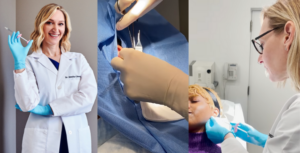
Are you suffering from a torn or split earlobe? Unfortunately, earrings can come with a cost that affects the look and function of your ear piercing. Thankfully, there are many earlobe repair treatment options, from surgical to filler injections, that we offer at UnionDerm.
Can you explain the different techniques for earlobe repair?
Split or torn earlobes that evolve from stretched-out piercing sites are a common problem. Split earlobes can be caused by trauma, wearing heavy earrings over time, metal allergies, poor piercing technique, and volume loss due to aging.
What are the different types of earlobe tears?
There have been various surgical techniques described for repairing torn earlobes (also known as a partial cleft or a complete cleft when the earlobe has been completely torn). These reconstruction techniques are based on the degree of the tear and have been subclassified as types 1, 2, and 3.
Type 1
Type 1 tears include a perforation in the earlobe where the length of the opening is shorter than normal. The measurement is taken from the lower end of the cleft (natural indentation or groove) to the lower edge of the earlobe.
Type 2
In type 2 tears, the perforation in the earlobe is elongated, and its length exceeds the normal measurement.
Type 3
Type 3 earlobe tears are the most severe and involve a complete earlobe split.
How do the different earlobe repair procedures compare to one another, and what are the benefits of each treatment?
When the earlobe tear is small, there is the option to perform a simple repair (side-to-side closure) by excising the piercing site with an elliptical excision or punch biopsy. This is one of the easiest ways to repair a torn ear-piercing site and is preferable if the tear is small. However, this can elongate the earlobe depending on the size of the tear and the shape of the earlobe. An alternative option is to perform a purse-string closure. In this method, the central piercing site is excised, and a single suture is run along the circular excision site, creating a purse-string appearance.
If the tear involves the lower third of the earlobe or, in the case of a small earlobe, it may require converting the partial tear to a full tear and suturing it together (in this case, a wedge of tissue is removed, and the earlobe is sutured in a line both front and back). A potential disadvantage of this method is that the inferior margin of the earlobe can sometimes heal with a contracted scar, causing a groove or notch. Specific suturing techniques can prevent this, and surgeons often combine the excision with an L-plasty or Z-plasty to prevent the earlobe from notching at the bottom.
Various techniques have been described for repairing the torn earlobe while preserving the piercing site. In some cases, the earring is placed at the time of the repair, and the remaining tear is sutured. There is potentially a higher risk of cleft recurrence with this technique as the weight of the earring pulls on the weakened scar tissue.
Reconstructing larger defects, as in the case of gauge deformities, often requires tissue rearrangement or flaps to preserve earlobe volume.
Who are the right candidates for earlobe repair, and what are the indications for earlobe repair?
Candidates for earlobe repair must have indications of a tear present. Indications for earlobe repair include complete tear and/or elongation of the piercing site so that earrings risk falling through the perforation. Another reason to repair the site is if an individual no longer desires an ear piercing.
Can individuals of all ages receive earlobe treatment?
Torn earlobes can affect individuals of all ages. While it is a more common occurrence with age, torn earlobes can occur even in younger individuals, especially if the earlobe is pierced too close to the margin. Split earlobes are becoming increasingly common as it has become trendier to have multiple ear piercings.
How extensive is the surgery, and what is recovery like?
Surgery is performed in our outpatient offices. Depending on the degree of the tear, it usually only requires a local injection of lidocaine to numb the area. A nerve block may be performed for the patient’s comfort if more extensive surgery is required. A pressure dressing is placed for the first 24 hours. After 24 hours, the dressing can be removed, and the site is cleaned and covered with Aquaphor and a bandage. Sutures are removed after a few weeks. It is usually not recommended to re-pierce the site until it is completely healed after a few months.
Once the surgical site heals, many patients benefit from adding dermal filler (such as hyaluronic acid) to the earlobe to give greater support to the scar tissue before re-piercing. This is especially valuable as we age, and our earlobes lose volume.
Some patients may be worried about scarring after treatment. What would you tell them about your hidden scar and non-invasive techniques?
Depending on the repair, the scar may be very small or barely noticeable. In the case of a groove or notch that forms at the earlobe margin, it can be surgically repaired, or sometimes dermal filler can be used to correct it. Noticeable scars are often rare and treatable with lasers.
In what ways do you see earlobe repair procedures change your patient’s quality of life?
Repairing torn earlobes reduces the risk of a complete tear, which can be painful and result in greater deformity. Once the tear is repaired and the site is re-pierced, patients are often excited to wear jewelry they have avoided due to the risk of it falling out.
Schedule a Consultation
If you are interested in whether you would be a good candidate for earlobe repair surgery, schedule a consultation with us at our New York City or Hamptons offices by filling out our online contact form today.

